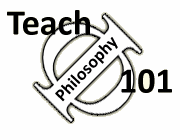Teach Philosophy 101
Free resources for
philosophy teachers!
"One of the most comprehensive, well-researched, and accessible guides for teachers that I have ever seen." James Lang, Chronicle of Higher Education (read full review of TΦ101)
Setting Goals
If you start your planning with course goals, the materials, pedagogy, and assessment will flow from those goals. There are a variety of ways to think about goals, but we will discuss a simple model presented in Teaching First-Year College Students (Erickson, Peters, and Strommer 50-62); Their approach focuses on four goals:
1. Knowing: memorizing. Knowing and memorizing are an important part of an intro course. If our students are going to be educated people, they ought to know who some of the great philosophers are and what they said, and they should know some of the concepts and arguments that are in the texts that they have read.
Objective tests are one easy way to measure whether this knowledge has actually been learned. For example, an exam on John Locke might include questions such as:
-
How does one become a slave, according to Locke?
-
What does Locke mean by the “state of nature”?
-
How does one acquire property in the state of nature?
-
Does money exist in the state of nature? Explain your answer.
2. Understanding: the ability to recognize. A more advanced skill is relating concepts to specific examples. This kind of thinking is often required for class discussion, papers or essay questions, as for example, in an essay question, when a student is asked to apply utilitarianism to a specific case that the student has not seen before. It can also be used in short answer questions on tests. For example, Michael Burke at Villanova University used to test students by giving the students a series of false statements about the ideas taught in the class, asking the students to explain why they were false. Here the student has to realize which information was relevant and apply it to a specific question. So for example, the question might be:
Explain why this is false: "Locke believes that, in the state of nature, a person may only have as much property as he can use for himself or his family." (This is false, since Locke limits acquisition of property not to use but to lack of spoilage).
3. Thinking: applying what one has learned. At an even higher level of abstraction, a student should learn to “use what one has learned to solve a problem, explain cause and effect, draw a conclusion, make a recommendation, critique an argument, and a host of other things” (Erickson, Peters, Strommer 54). This skill is often required in class discussion and also in writing papers, where students develop a thesis about a text, compare two different texts, or critique or defend and argument.
4. Learning how to learn. Erickson, Petters, and Strommer also add another goal, which is helping students learn how to learn. Most of our intro students will probably not major in philosophy, and we often “sell” philosophy courses by promising that students who take philosophy will learn skills that will assist them in other fields. If we are going to make this promise, we probably out to spend some time being reflective about strategies that will be helpful to them, such as how to read difficult texts, write analytic papers, critique arguments, and so on.
In planning a course, then, it is useful to start with some system of cognitive levels (either the one above or any other) and ask yourself which of the levels are important, what parts of the course will help the students work at these levels, and how you will assess them. If you read further about cognitive levels, you will encounter Bloom's Taxonomy, a more detailed approach than the one presented above.
Sources:
Bette LaSere Erickson, Calvin B. Peters, Diane Weltner Strommer (2006). Teaching First-Year College Students. San Francisco: Jossey-Bass.
Michael Cholbi presents an integrated way of thinking about goals and teaching activities specifically in philosophy courses. His goal is to move students along the following continuum: resistant learners; conforming learners (who digest information and return it without processing it); performing learners (who learn diligently but only for external rewards); and intentional learners (who are motivated by a desire for expertise). He goes on to describe teaching activities designed to move philosophy students toward becoming intentional learners. "A Model for Philosophical Pedagogy." Teaching Philosophy. 30:1 (2007) 35-58.
Maria Cimitile uses Bloom's Taxonomy both as a way of teaching and assessing student work. Her article gives a good sense of how useful an understanding of educational goals can be in teaching a philosophy class: see "The Use of Bloom's Taxonomy in Feminist Philosophy." Teaching Philosophy. 31:4 297-310.
Dee Fink has a more detailed set of goals in his short and brilliant IDEA paper, "Integrated Course Design." Fink argues that a teacher should begin with "Situational Factors" (rather like our Challenges and Obstacles), then set goals, assessments, and finally teaching activities. In addition to the goals described above, he also adds two other goals: "Caring," and "Human Dimension," ("learning about oneself and others"). IDEA Paper #42, March 2005. April 8, 2008.
Update: May 16, 2010
Author: John Immerwahr
